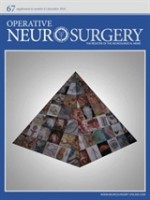The Basal Temporal Approach for Mesial Temporal Surgery: Sparing the Meyer Loop With Navigated Diffusion Tensor Tractography
Neurosurgery. 2010 Dec;67(2 Suppl Operative):385-90.
Thudium MO, Campos AR, Urbach H, Clusmann H.
Department of Anesthesiology, University of Bonn Medical Center, Bonn, Germany. Marcus.Thudium@ukb.uni-bonn.de
Abstract
BACKGROUND: Visual field defects are a common side effect after mesial temporal resections such as selective amygdalohippocampectomy (SelAH).
OBJECTIVE: To present a method of diffusion tensor tractography (DTT) of the Meyer loop for preoperative planning of the surgical approach for SelAH and for intraoperative visualization on a navigation-guided operating microscope.
METHODS: Twelve patients were selected for SelAH to treat mesial temporal lobe epilepsy. All received preoperative MRI with diffusion tensor imaging sequences. The Meyer loop was determined and reconstructed as an object with DTT. Images were utilized for preoperative planning in which a safe approach not affecting the Meyer loop was specified. A navigation-guided operating microscope was used for image-guided surgery.
RESULTS: DTT was a reliable method for visualization of the Meyer loop. Reconstruction of the Meyer loop had a direct impact on the approach planning. In all 12 cases, the optic tract could only be spared using a basal approach. Ten patients underwent SelAH by the subtemporal approach, and 2 underwent SelAH by the transcortical approach through the inferior temporal gyrus. During the critical early phase of the operation image guidance remained accurate until entry into the ventricle. Nine of 12 patients had no postoperative field deficits (75%). Three patients (25%) experienced peripheral incomplete quadrantanopia.
CONCLUSION: DTT and intraoperative visualization of the Meyer loop is a helpful tool for preoperative planning and during surgery to find a safe trajectory to mesial temporal structures while avoiding the optic radiation. This technique in combination with a basal approach seems to be a promising strategy to prevent postoperative visual field deficits in most patients.

